The 2015 MacBook Review
by Ryan Smith on April 14, 2015 10:15 AM ESTThe MacBook's Design
In terms of overarching design, the MacBook is both treading new ground and much of the same. As we’ve mentioned before, the big promotional point for the MacBook is how small it is. And yet at the same time Apple has retained more or less all of the stylings that have come to define the modern unibody MacBook family design. The end result is a laptop that looks and acts almost exactly like a smaller MacBook Air or Retina MacBook Pro.
This leads to the new MacBook having all of the contours and finishes we have come to expect from a MacBook family laptop. The all-aluminum unibody design continues to impress and holds up well even with the MacBook’s smaller form factor. For the MacBook in particular it serves two goals for Apple, the first being to give the device a premium feel, but the second is to serve as a means of cooling the MacBook.
For one of the biggest changes in the MacBook compared to the MBA is the fact that this is a completely fanless design. There are no fans or even vents on the laptop to move heat or hot air; the closest thing that comes to a vent is the grating at the top of the laptop, above the keyboard, which houses other items such as the speakers. Otherwise all real heat dissipation is carried on by the aluminum case itself, which in turn is made practical by the use of the ultra-low power Core M processor. This also means that the MacBook is silent, containing no motorized parts and the only moving parts being the keyboard keys, the trackpad, and the screen hinge. The MacBook Air for its part was seldom loud, but for whisper quiet there’s no topping fanless.
Moving on, Apple retains the sloped design of their MacBook Air, leading to this MacBook having a similarly variable thickness. At its thickest part, towards the rear of the laptop, it’s just 13.1mm thick, and towards the front of the laptop this narrows to just 3.5mm. As with the MacBook Air I’m not sure if this sloped design is really necessary or beneficial versus a flat design, or if Apple does it merely to show off, but if you like your wrists low to the table, then at 3.5mm at its thinnest point, the MacBook is among the thinnest. Meanwhile the fact that the edges are also curved makes the MacBook deceptively thin overall, as even at 131mm it doesn’t feel even that thick when grabbed from the edges.
Perhaps the most notable – and admittedly cosmetic – change from the MacBook Air is the Apple logo on the top of the laptop. The iconic lit white logo is gone in favor of a black mirrored logo in its place. Apple doesn’t specifically address the logo, but with the tight constraints on both thickness and battery life – Apple needs to get 9+ hours off of a 39.7Wh battery driving a 12” Retina display – I suspect Apple finally sacrificed the logo to further save on power.
The other big cosmetic change here is the color of the aluminum laptop body itself, which in a first for an aluminum Mac now comes in multiple colors. Further reinforcing the crossover nature of the device and its place between a tablet and a traditional laptop, the MacBook comes in the current iOS device colors of Silver, Space Grey, and yes, Gold. Silver will be the closest to the traditional aluminum look, Space Grey is as close as you’ll get to a black MacBook, and Gold continues to defy our own expectations and be a popular color on Apple devices. Overall the current coloring is limited to just the MacBook, but given Apple’s drive for style, I wouldn’t be all that surprised if this eventually came to the Retina MacBook Pro as well, though perhaps not the MacBook Air for cost reasons.
I also want to quickly call attention to the lid hinge in the MacBook, which is something I feel Apple has done very well with. In such a thin and light laptop the percentage of the laptop’s weight that’s carried by the screen/lid has gone up, which risks the laptop becoming top-heavy. Not only has Apple managed to avoid a top-heavy design, but the hinge is as perfectly balanced as I’ve ever seen. The hinge is just loose enough that even trying to quickly lift the lid can’t really torque the laptop’s base up, and yet no looser than it needs to be. As a result the hinge still offers plenty of resistance without it being a problem for the relatively light base, and the laptop can easily be held at 90° without the lid dropping.
Moving on, we’ll cover the ports in depth a bit later, but we did want to quickly note the MacBook’s choice in ports while discussing the design. In another example of Apple minimalism – or maybe just another sign of the tablet/laptop crossover – the MacBook only has 2 ports: a USB Type-C port, and a 3.5mm combo jack for audio. All wired power, data, and video is routed over the single Type-C port, and the laptop itself is thin enough that there’s not room for something much larger, at the very least not without making the laptop thicker or eliminating the base’s curved sides. This makes the MacBook very much like an iPad, with its single Lightning port and a 3.5mm combo jack, and has some definite repercussions for usability.
With regards to internal design there’s not a lot we can say at this time – Apple doesn’t like us disassembling review samples – but in lieu of the eventual iFixit teardown, Apple has posted a handful of sanitized shots of the MacBook’s internals. Apple is keen to show off the MacBook’s miniscule logic board, which is only 1/3rd the size of the 11” MacBook Air’s board. Much of this is enabled by the use of the Core M processor, itself using an especially small package to leave room for other components. This is combined with a highly integrated design that sees the RAM soldered on the board, and I suspect the SSD as well, meaning virtually nothing here is replaceable short of the entire logic board itself. In any case, along with this Apple has forgone some of the 3rd party chips like Intel’s Thunderbolt controller, which reduces to a minimum the number of chips they need alongside the Core M processor.
Update 04/15/2015: The iFixit MacBook teardown is in, giving us some excellent shots of the logic board. These pictures show us just how little is there beyond the Core M CPU, the RAM, SSD, a couple of extra controllers, and the necessary power management hardware.
With such a small logic board, Apple has filled out the rest of the laptops internals with batteries, 39.7Wh worth to be precise. This ends up being just a bit more than the 11” MBA’s 38Wh battery, again despite the smaller overall footprint, and is a result of Apple’s use of their new layered lithium polymer batteries, or as Apple likes to call it, their terraced, contoured battery cells. Overall LiPoly has slightly lower energy density than Lithium Ion, however in return it’s a more malleable medium, allowing for greater shape customization, which is what Apple is taking advantage of here. The end result is that Apple is able to better fill out the sloping, rounded case of the MacBook with battery cells by terracing them, squeezing out what little space would have otherwise remained.
Taken in overall, the MacBook has a distinct iOS-device feel to it at times. This is most immediately apparent from the selection of chassis colors, but digging deeper it extends into the electronics and internal design choices as well. Pairing a relatively large screen with a small logic board and filling out every nook & cranny with batteries is very much the iPad way of building things, never mind the fact that the Core M processor itself is designed in part to be a high-end tablet processor. Then of course is the port selection: just a single combined power/data port, and then the 3.5mm jack for audio.
The end result is a device that has an interesting laptop/tablet crossover design to it. The MacBook is still without a doubt a Mac laptop, but it’s also more like an iOS device than anything before it. Consequently while it’s still primarily meant to be used as a laptop – just a very portable, very light one – it’s also clear that Apple envisions it being used like a tablet. To be charged overnight, carried around and run during the day, and then put back on its charger for the night.


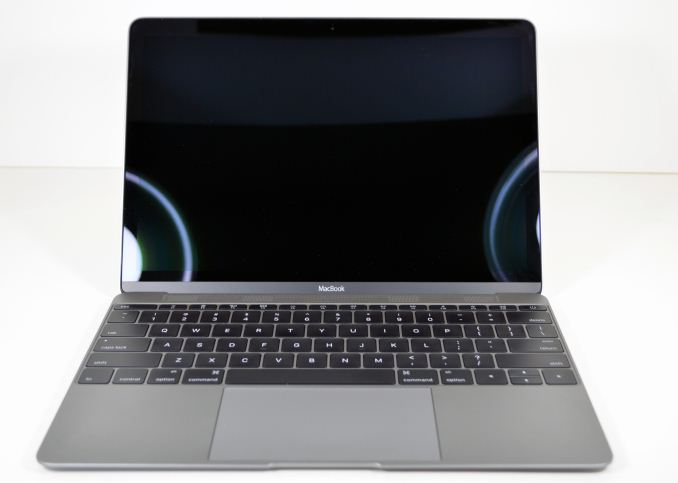
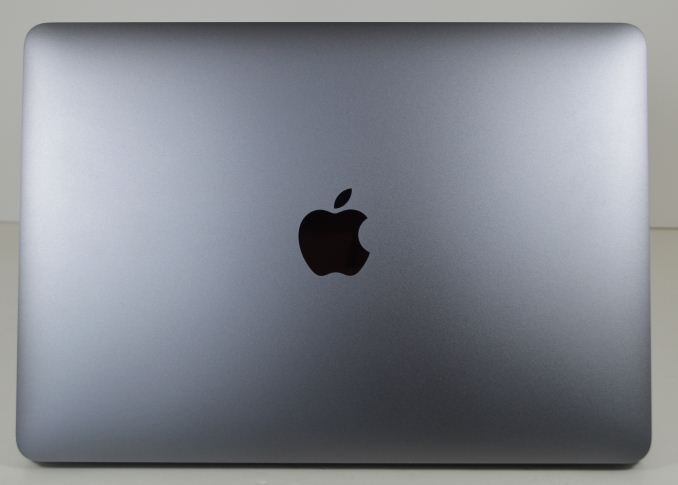
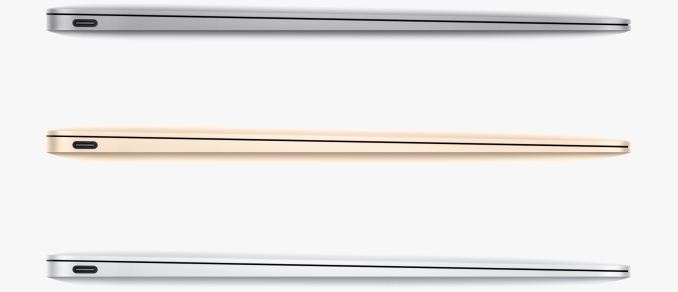
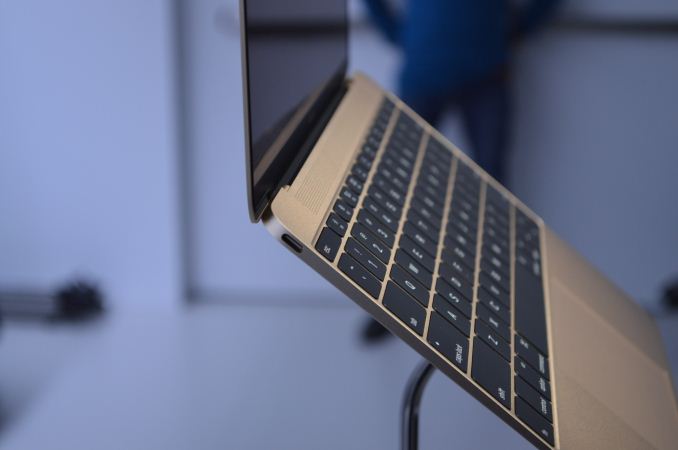

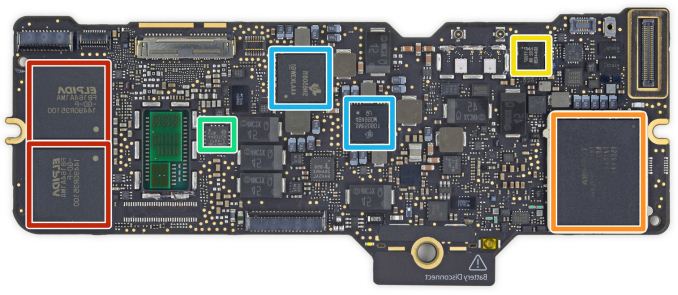










354 Comments
View All Comments
darwinosx - Tuesday, April 14, 2015 - link
If you recall back then $400 was cheap. Now you can buy a cheap Acer etc. Windows laptop for around that. But the are junk.Impulses - Tuesday, April 14, 2015 - link
$400 was cheap then? Because inflation goes in reverse? :p I don't know if you can say $400 was a small sum, I guess in relative terms you could argue most laptops were over $600... That seems like splitting hairs tho, a year or two later C2D laptops were encroaching on netbook prices and ultrabooks started looming in an effort to bring premium systems and prices into the limelight.barleyguy - Tuesday, April 21, 2015 - link
In computers, yes inflation goes in reverse. Computers have gotten more powerful and less expensive over time. The original 8086 IBM PC was $7000.MykeM - Tuesday, April 14, 2015 - link
The x7 in the Surface 3 is nowhere as powerful as the Core-M. It's even less powerful than the A8X despite having one extra core (and even less than the A8 in single core Geekbench 3 score):A8X (3 cores): 1808/4529 (single/multi)
x7-Z8700 (4 cores): 1024/3445
Core M-5Y31 (2 Cores): 2446/4615
kyuu - Tuesday, April 14, 2015 - link
FFS, please stop quoting Geekbench like it's a reliable benchmark.68k - Wednesday, April 15, 2015 - link
Amen to that!Geekbench score has some merit when comparing the same family of CPUs, like comparing one big-core Intel vs another big-core Intel. Comparing Geekbench result from different ISA seem to make little sense as the relative score is often quite far from what one see when comparing "real" programs.
Gogogoran - Wednesday, April 15, 2015 - link
I bought an eeepc 1000he as a more mobile laptop since my 15.4" at the time was becoming a pain with its lackluster battery life of 2.5 hours real life, 3.5 if I tried. I have been meaning to upgrade to a SSD and 2GB ram but I feel that would still be limiting with the low resolution screen and single core atom. Still works great after over 5 years.I'd argue that the true functional successor is the Transformer T100 and other OEM equivalents. Its cost is also on par with the original Asus eeepcs and is far more functional, even taking into account the time frame. The surface 3 I would call a premium netbook. I'm kinda more interested to see asus's transformers with the x7 when they come out. I was admittedly disappointed when the new chi line came out with the same internals as the T100 and at the top end core M. Ah well. I have a yoga pro 2 and I'm content with just about everything as my sole mobile PC now and I'm glad to not be shifting between two laptops anymore.
darwinosx - Tuesday, April 14, 2015 - link
Calling this a netbook is the easiest, laziest, and most ignorant response to make. Typically by people who have some whiny anti-apple issue.Netbooks were cheap laptops with substandard everything. Now there are even cheaper laptops with lousy displays, build quality and of course they run Windows.
PEJUman - Tuesday, April 14, 2015 - link
No Netbook from functionality standpoint is an ultra efficient, relatively low performance, severely limited IO compromise to the 2012 laptop market. From that functionality standpoint, this macbook is a netbook.Core M is still slow according to 2015 standards, the macbook still only have a single USB port. Both of this makes it a 2015 netbook, albeit a premium one, around $800ish gets you the nicer material and screen, but not functionality.
I still can't do reasonable FPS on 4K encodes with it, it still will not run my USB to CAN bus adapter. I still need a hub to run multiple USB devices, etc. The same relative feature and performance compromises between laptop-netbook still here. Both devices evolved (and our expectation should as well), in the past 3 years since netbook term was coined.
ppi - Tuesday, April 14, 2015 - link
First netbooks arrived like 8-9 years ago. iPad & tablets completely annihilated that category. Any el cheapo Android tablet can do more than Vista-powered Atom with 1GB RAM and mechanical HDD paired with 1024x800 TN panel.MacBook Core-M performance is absolutely perfect for anyone doing mostly e-mails, office, browsing. Short, burst, tasks. Doubtful you would be able to tell difference at these tasks between Core-M and i7-4790.
Obvisously, the 4.5W power envelope has its downsides - most demanding game this could reasonably run is probably something like plants vs zombies. But then you would get rewarded by great portability when running around airports.
If your performance yardstick is video encoding, anything short of full desktop is unsatisfactory anyway.